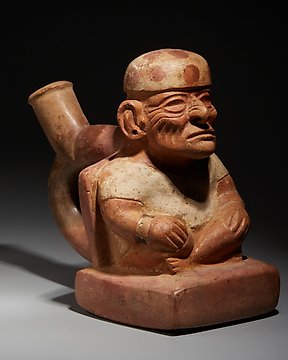
Moche, Perù Terracotta Huaco sotto forma di prete. TEST TL 600-900 d.C. Altezza 13,8 cm. Esportazione spagnola
N. 83535323

N. 83535323

Container in the shape of a male figure.
CULTURE: Moche, Perú
PERIOD: 100-300 AD.
MATERIAL: Terracotta
DIMENSIONS: Height 32.2 cm
CONDITION: Good condition. It has small tears on the upper part and on the body.
PROVENANCE:
It has an inscription from 1898 on the base.
-Private collection of Jean Pierre Cottier and Fiorella Cottier-Angeli, Geneva, Switzerland. Acquired between 1960 and 1980, from, among others, Carlos Campilli (Miami, United States of America), Sophie Pdgorska (Geneva, Switzerland) and Marguerite Motte (Paris, France).
DESCRIPTION:
The Moche culture inhabited the coast of present-day northern Peru, concentrating in the valleys of Lambayeque, Chicama, Moche and Virú. This desert region is crossed by several rivers that flow down into the Pacific Ocean, where marine resources are plentiful.
The Moche produced fine ceramic, textile and precious metal pieces. Their characteristic style can be seen in a wide range of goods such as fire-engraved gourds, wall murals, featherwork art, body painting and tattoos. Their ceramic decoration displays a level of skill that has rarely been surpassed, and included such techniques as incision, bas-relief with stamps, and painting on smooth surfaces. Many were made in state-run workshops that mass-produced pieces from molds. Their ceramics came in a variety of forms and decorative styles and displayed myths and ritual motifs as well. Notable among these earthenware forms were the so-called “portrait bottles”, bottles molded with the face of a well-known Moche figure. These highly detailed facial portraits reflect the Moche’s own use of face paint and/or tattoos, as well as elaborate headdresses. This portrait-making expertise can also be observed in everyday scenes and erotic representations, as well as in figures of individuals that were hunch backed, blind, or suffered from other disorders. They were skillful metalworkers, using gold, copper and silver to make ear ornaments, nose rings, bracelets, necklace beads, tweezers and a variety of tools. Especially notable is the tumi or ceremonial knife that was usually only carried by Moche officials.
Many of the motifs adorning early Moche ceramics were derived from the Recuay culture. These two peoples were certainly in contact, as all of the irrigation waters the Moche used in their valleys flowed down from Recuay territory. In the early years, the Moche also had contact with groups of the Salinar and Gallinazo cultures. It is very likely that the Moche disappeared when they were overtaken by the Wari Empire, but their civilization also suffered from long periods of flooding by the El Niño phenomenon, which would have destroyed their farming infrastructure and could have helped precipitate their collapse. The final stage of the Moche culture displays features that would later appear in the Chimú culture.
Notes:
The seller guarantees that he acquired this piece according to all national and international laws related to the ownership of cultural property. Provenance statement seen by Catawiki.
The seller will take care that any necessary permits, like an export license will be arranged, he will inform the buyer about the status of it if this takes more than a few days.
The piece includes authenticity certificate.
The piece includes Spanish Export License.
Come fare acquisti su Catawiki
1. Scopri oggetti speciali
2. Fai l’offerta più alta
3. Paga in tutta sicurezza